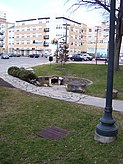Acorn Park
| Acorn Urban Park | |
|---|---|
| Acorn Park | |
 Acorn Park in 2008 | |
 | |
| Type | Urban park |
| Location |
|
| Coordinates | 38°59′23″N 77°01′44″W / 38.9896°N 77.0290°W |
| Area | 0.1247 acres (0.050 hectares) |
| Established | 1942 |
| Etymology | Acorn–shaped gazebo |
| Owned by | Maryland-National Capital Park and Planning Commission (M–NCPPC) |
| Administered by | Montgomery Parks |
| Open | Sunrise to sunset |
| Public transit access | |
| Website | MontgomeryParks.org/Parks-and-Trails/Acorn-Urban-Park |
Acorn Park is a 0.1247-acre (500-square-metre) urban park in downtown Silver Spring, Maryland, which features an acorn-shaped gazebo and an artificial grotto.[1] The site is historically significant as it is thought to be the location of the "mica-flecked spring" that in 1840 inspired Francis Preston Blair to name his estate "Silver Spring".[2][3][4][5][6][7]
Acorn Park is located at the intersection of East-West Highway and Newell Street.
History
[edit]The gazebo in Acorn Park was constructed in 1842[8] by Benjamin C. King.[9] Francis Blair's son-in-law, Samuel Phillips Lee, had the stone grotto built at the site of the spring in 1894. It originally included a statue of a Greek nymph.[9] The park land was purchased by the Maryland-National Capital Park and Planning Commission in 1942[10] and was refurbished and rededicated in 1955.[8] A small additional tract of land was acquired by M-NCPPC in 1997, to make the current 0.1247 acres (0.05 ha).
Gallery
[edit]References
[edit]- ^ "Parks and Trails Atlas of Montgomery County, MD — ArcGIS Web Application". MCatlas.org. Retrieved February 12, 2019.
- ^ "Acorn Urban Park". MontgomeryParks.org. October 30, 2018. Retrieved February 12, 2019.
According to local history, in 1840 a newspaper publisher and friend of President Andrew Jackson, Francis Preston Blair, discovered the spring bubbling up through shiny mica sand.
- ^ Sheir, Rebecca (April 4, 2014). "The Man Who Discovered Silver Spring's 'Silver Spring'". Washington, D.C.: WAMU 88.5 – American University Radio. Retrieved February 12, 2019.
Silver Spring Historical Society president Jerry McCoy at Acorn Park: the site thought to be where Preston Blair discovered the original 'silver spring'.
- ^ "A Brief History of Silver Spring" (PDF). MontgomerySchoolsMD.org. Cannon Road Elementary School, Montgomery County Public Schools. Archived from the original (PDF) on January 26, 2019. Retrieved February 12, 2019.
Acorn Park, tucked away in an area of south Silver Spring away from the main downtown area, is believed to be the site of the original spring.
- ^ "Acorn Park". SilverSpringDowntown.com. Retrieved February 12, 2019.
Acorn Park is all that remains of Francis Preston Blair's estate, 'Silver Spring,' named after his discovery in 1840 of a nearby mica-speckled spring.
- ^ "Acorn Park". Celebrate Silver Spring Foundation. 2006. Archived from the original on September 3, 2007. Retrieved March 24, 2007.
- ^ "Montgomery Park: Heritage Sites - The Silver Spring". MontgomeryParks.org. Montgomery County Department of Parks. April 25, 2008. Archived from the original on May 22, 2008. Retrieved April 28, 2008.
- ^ a b McCoy, Jerry A. (2004). "Happy Birthday, Acorn Park". Silver Spring, Then & Again. Takoma Publishing, Inc. Archived from the original on March 29, 2006. Retrieved March 24, 2007.
- ^ a b McCoy, Jerry A. (2005). Historic Silver Spring. Silver Spring, Md.: Arcadia Publishing. pp. 26–32. ISBN 0-7385-4188-5.
- ^ "MNCPPC: Acorn Urban Park". M-NCPPC. Archived from the original on April 15, 2008. Retrieved April 28, 2008.
External links
[edit]- Official website

- Acorn Urban Park on the Parks and Trails Atlas of Montgomery County, Maryland



